Conformational control of the self-assembly of triple helicates and [2 × 2]-grids from zinc(ii) and 3,6-di(2-pyridyl)pyridazine based ligands†
Abstract
The reaction of symmetrical ligands based on 3,6-di(2-pyridyl)pyridazine (L1) with carbocyclic rings fused to the pyridazine ring; 7,10-di(2-pyridyl)-8,9-diazafluoranthene (L2), 1,4-di(2-pyridyl)-6,7-dihydro-5H-cyclopenta[d]pyridazine (L3), 1,4-di(2-pyridyl)-5,6,7,8-tetrahydrophthalazine (L4), 1,4-di(2-pyridyl)-6,7,8,9-tetrahydro-5H-cyclohepta[d]pyridazine (L5) in reactions with zinc perchlorate gave a series of complexes (1–6). Characterisation of these using single crystal X-ray structure determination showed that less sterically hindered L1 and L3 gave saturated triple helicates (1 and 3, respectively), while [2 × 2]-grids were formed with more sterically hindered ligands (4 from L4 and 5 from L5), or if methanol (rather than acetonitrile) was used as the reaction solvent with L3 (6). The most sterically-hindered ligand L2 formed a mononuclear complex (2). The structures of these complexes in solution was determined by 1H-NMR, and found to match their solid-state structures. The [2 × 2]-grids are effective molecular clips able to hold solvent and anions between their arms via hydrogen bonding to a Zn4(H2O)2(OH)2 core.
![Graphical abstract: Conformational control of the self-assembly of triple helicates and [2 × 2]-grids from zinc(ii) and 3,6-di(2-pyridyl)pyridazine based ligands](/en/Image/Get?imageInfo.ImageType=GA&imageInfo.ImageIdentifier.ManuscriptID=C4DT01416B&imageInfo.ImageIdentifier.Year=2014)

 Please wait while we load your content...
Please wait while we load your content...